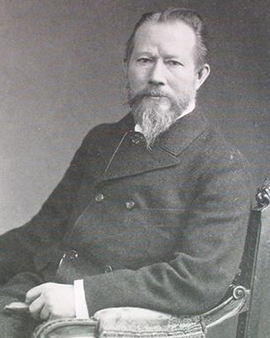Posterity has long treated him like a stepmother. But during his lifetime Adelsteen Normann was a sought-after painter who enjoyed prestige and prosperity.
His first successes, while still a student at the Düsseldorf Art Academy under Oswald Aschenbach and later Eugen Drücker, continued in a dense series of renowned exhibitions worldwide, including two world exhibitions and the Paris Salon. Normann's works have received numerous awards and were well received by prominent buyers such as Kaiser Wilhelm II. How did Normann, unlike many other artists, achieve artistic and financial success during his lifetime?
Normann painted for the market and the taste of the time. With fjord views from his native Norway, namely the tourist areas along the Sognefjord, Nærøyfjord and Romsdalfjord, he met the travellers' demand for souvenirs. Adelsteen was particularly famous for his fjord landscapes with midnight sun. The clever choice of motifs was complemented by his artistic qualities. He painted close to the motif from a boat and used his own photographs as models, e.g. for larger compositions in his studio. He refrained from giving details of the places and dates. The development from subdued colours to strong contrasts of bright colours, from the fine stroke of the smooth brush tip to the two-dimensional application with a wide spatula also shows the artist at work, as does the reflection of various art movements of the time. While his relationship to the Vienna Secession has not been finally clarified, the increasing influence of Impressionism is clearly evident. The working world of the locals, to which the Nordic National Romanticism paid attention, was not reflected. His artistic work provided Adelsteen with a pleasant life in the best districts of Düsseldorf and later Berlin. From 1890/91 he spent his summers in his dragon-style villa in Balestrand on the Sognefjord. When in 1910 the architect he had commissioned to build a house in Berlin left for America with the money, Normann was able to free himself from bankruptcy thanks to painting. Art as business?
This thesis does not do justice to Adelsteen Normann. Adelsteen was an active member of the art scene of his time. In Düsseldorf he was a member of the Künstlerverein Malkasten, in Berlin he was in contact with Walter Leistikow, Max Liebermann, Franz Skarbina, Max Uth and the art historian Hermann Beenken and was a member of the Verein Berliner Künstler. He discovered and supported Gunnar Berg and recognized the talent of Edvard Munch, to whom he procured an exhibition in Berlin. This exhibition - anticipated by Adelsteen, an art expert - caused such a stir up to the imperial court that it was closed after a few days. His painting school in Berlin, which was mainly attended by young ladies, is known less for the success of its students than for his relationship with Luise Rostalski, from whom the son Adelsteen Jr. emerged in 1909. Since his wife Catharine Hubertine Weitgan refused a divorce, they did not marry until after her death in 1911. In 1917 Adelsteen Normann died in Norway from the Spanish flu.
×





.jpg)
.jpg)
.jpg)
.jpg)
.jpg)
.jpg)
.jpg)
.jpg)
.jpg)
.jpg)
.jpg)
.jpg)
.jpg)
.jpg)
.jpg)
.jpg)
.jpg)
.jpg)
.jpg)
.jpg)
.jpg)
.jpg)
.jpg)
.jpg)
_-_(MeisterDrucke-901897).jpg)
_-_(MeisterDrucke-901897).jpg)
.jpg)
.jpg)
.jpg)
.jpg)
_-_(MeisterDrucke-1319698).jpg)
_-_(MeisterDrucke-1319698).jpg)
.jpg)
.jpg)
.jpg)
.jpg)






